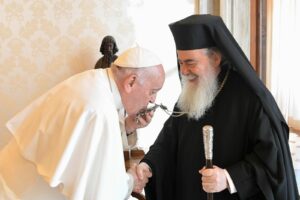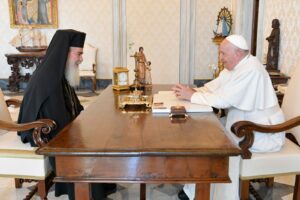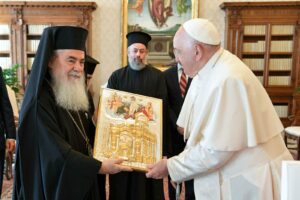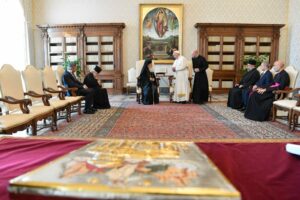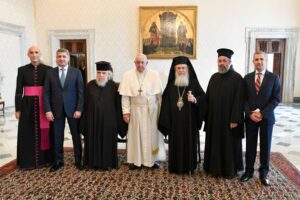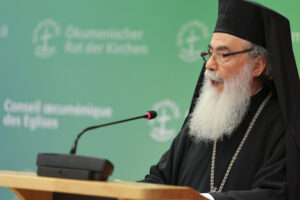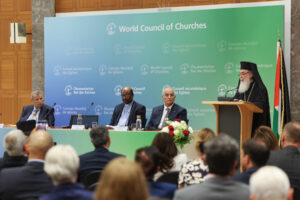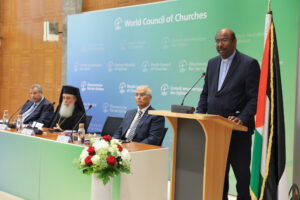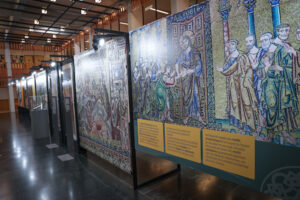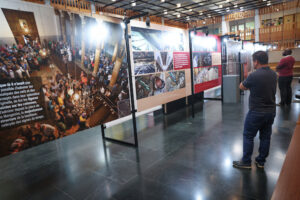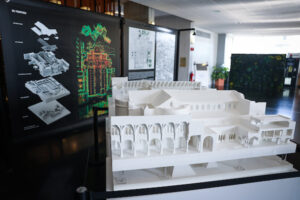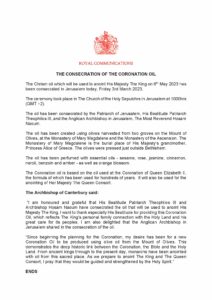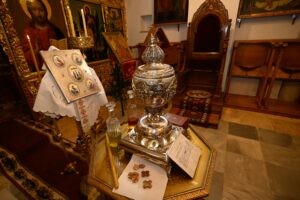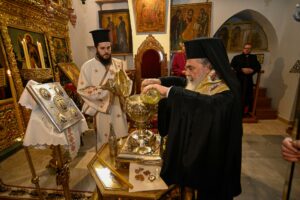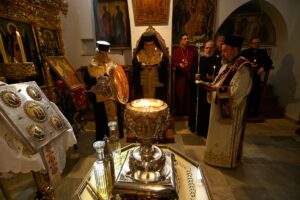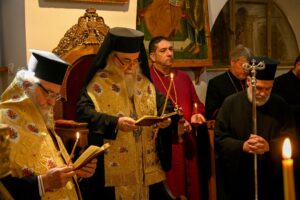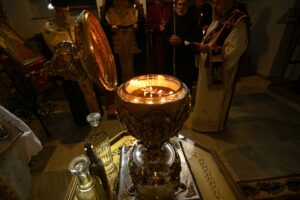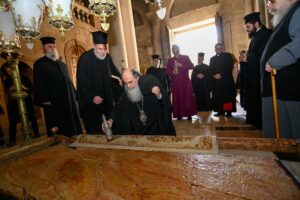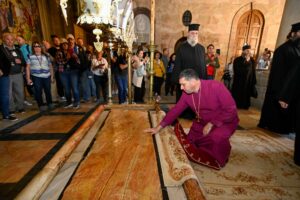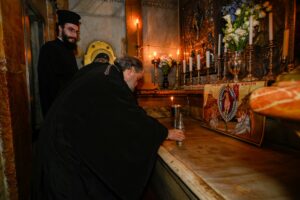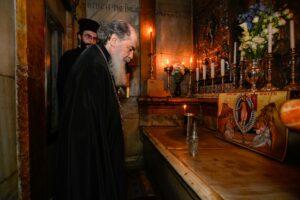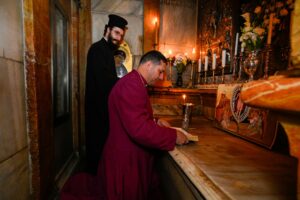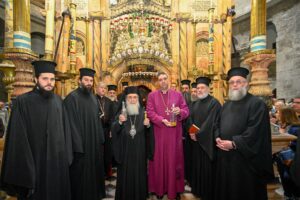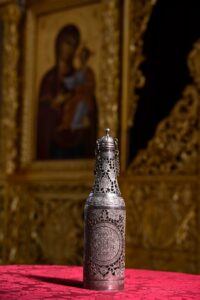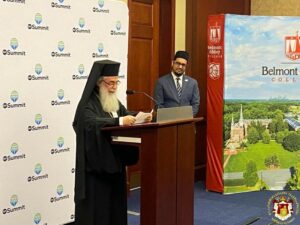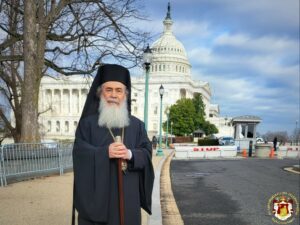Canary in a Coal Mine: The Case of the Churches and the Status of Jerusalem
By: Anna Koulouris – Palestine-Israel Journal
When one asks what the future for Israel and Palestine might look like, visions of what it could and should be — as opposed to what is taking place on the ground — are increasingly disparate. Here, Jerusalem is of utmost concern, since there is no conceivable negotiation that could take place without the Holy City at its center. And at the heart of the issue of Jerusalem lies the vital question of how to preserve the ever fragile Status Quo.
Jerusalem’s churches are natural advocates for maintaining the Status Quo, since it is built into their history, namely, the Ottoman firman of 1852, which preserved the status of the Christian holy sites. This preservation facilitates the churches’ general stance to allow open worship, without distinction or discrimination, and so it is built into their value system as well. Since the Status Quo was adopted into international law by way of the Treaty of Berlin and broadened to apply to all holy sites, even being recognized by the Israelis in 1967, although violated later in regard to the Al-Aqsa compound, maintenance and protection of the Status Quo has been crucial for peace. The churches’ advocacy extends to the protection of the compound, and all of Jerusalem’s holy sites.
But there is an important distinction to be made in the churches’ understanding of holy sites, which makes them a unique target of the settler agenda. In the Christian view, holy sites are not part and parcel of a nationalistic framework, but rather are understood purely in terms of their spiritual significance; hence the policy of inclusivity, and the churches’ emphasis on remaining independent actors. It may be for this exact reason that the churches have become a “canary in the coal mine” to the extent that the coal mine is a quick and quiet breakdown of the Status Quo, and that Jerusalem’s ancient multifaceted religious, ethnic, and cultural character is being irrevocably damaged.
It is important to emphasize that the growing boldness and impunity of radical settlers is harming everyone in Jerusalem and not only Christians. However, the churches provide a unique and effective target — a fact sometimes overlooked by outside observers. As independent, visible, ancient guardians of holy sites, as well as the largest landowners after the state, they have emerged as a symbol of what radicals seek to change about Jerusalem. Thus, moves against the churches have proven to be advantageous for political aspirants during recent election periods, including in terms of the support they receive from settlers who in turn perceive sponsorship, direct or indirect, of their often criminal activities. At the same time, settler groups secure Western Christian funds — posing as charitable organizations — from donors who are often unaware of the activities they support.
In the last few years there has been a series of actions attempted or executed by radical entities within and spanning the Israeli political arena, interweaving local and national governments, toward a unified agenda of weakening the Christian presence. These include court rulings that legitimize underhanded means of acquiring land, the introduction of discriminatory legislation, police and governmental interference in religious ceremonies, expansion onto church land for nationalistic purposes, and turning a blind eye to violence committed by Jewish radicals.
How Do the Churches Respond?
These days, the churches act in tandem, particularly when facing threats to their autonomy as religious institutions. The Patriarchate of Jerusalem provides a solid example of both the church’s autonomy and the essentiality of that autonomy, being the oldest institution in the Holy Land, and uniquely autocephalous over its jurisdiction. Over millennia, it survived dozens of takeovers of the city, wars, and challenges to its own existence. This is due to the posture that the church assumed amid tumultuous political realities, often captured with the Biblical verse, “Render therefore unto Caesar the things that are Caesar’s, and to God the things that are God’s” (Matt. 22:21).
An eminent example of this policy is found in the Arab Muslim takeover of Jerusalem in 637, when the Muslim Khalifa Omar Ibn al Khattab and Patriarch Sophronios, who emerged as a post-Byzantine ethnarch, signed a covenant in order to avoid war. The Patriarchate’s abdication of sole authority over Jerusalem not only saved lives but also provided a solution to a problem that leaders of that period foresaw would never have an ideal answer: How to share holy space upon which everyone lays legitimate claims.
Over centuries, the Patriarchate provided another benefit to the Abrahamic faith communities: it offered witness to their historical ties to Jerusalem and protected the sacred heritage which these faiths share — the places of divine-human encounter. To characterize the city thus is to see its inherent indispensability to all humankind. This reasoning informs the church’s policy toward inclusivity, which views Jerusalem as a city on a hill that can’t — that mustn’t — be hid. Ideologies to the contrary undermine the nature of Jerusalem, and deny people their natural right to venerate what is holy.
“Jerusalem is mentioned always as a model — not a theoretical, but a tangible model — of co-existence; a model of the Abrahamic religious co-existence, of civilization, and of cultures. This is what the world is in need of today,” says Patriarch Theophilos III of Jerusalem.
He and other Heads of Churches, as well as the Status Quo Committee, have signed joint letters, held press briefings, and even agreed to close the Church of the Holy Sepulcher in protest in early 2018 in response to a surprise move by the municipality to impose retrospective taxes equaling around $200 million on historically exempt church property. This move was particularly startling considering the special status of the religious institutions, the Status Quo of 1852, and philanthropic services the churches provide to the general population, including schools, nursing homes, hospitals, food distribution centers, and health clinics, which would have been immediately closed. During the visit of United States President Joe Biden in July 2022, the Patriarch outlined the church’s deepening concerns in a letter, to which he received a strong, supportive response. The situation on the ground has reached a level which has caught international attention.
What Are the Issues at Hand?
A wave of attacks against the churches beginning in 2017 emanated from the judicial, municipal, and national levels. Often, such moves can be traced back to individuals who sympathize with, receive support from, or work in the name of the settler agenda. Moreover, the initiatives appear to have a tendency to move vertically through official channels. For example, municipal initiatives may be adopted by ministries or Knesset members, settler initiatives may find support in the municipality, or Knesset bills may be supported by settler groups. Consequently, there exists an effective apparatus by which the status of Jerusalem may be altered, to the detriment of Jerusalem’s non-Jewish indigenous communities, and in betrayal of Israel’s declared commitment to freedom of worship, the protection of all its inhabitants and the diverse fabric of society in the Holy Land.
Radical Influence in the Judicial Sphere
The Jaffa Gate properties case is one of the most blatant examples of how settler activity is destabilizing the Old City. In July 2017, the Jerusalem District Court ruled in favor of radical group Ateret Cohanim, whose mission statement is to “redeem” Jerusalem from non-Jews. At the center of the case was the question of whether the unauthorized sale of Patriarchate property, situated prominently at the entrance of the Christian Quarter, was indeed a valid sale.
The deal had been attained through Ateret Cohanim’s frequent underhanded tactics, as documented by Haaretz journalist Nir Hasson. In 2004 the group, working under the cover of four different off-shore shell companies, bribed a junior employee in the church’s finance office to sign lease deals that he was never authorized to sign, and of which the Church’s synod and patriarch were unaware. In court, the church provided concrete evidence of bribery, bad faith, conspiracy, and that the deal lacked due authority from the Patriarchate. However, these and other strange circumstances surrounding the case were disregarded, including Ateret Cohanim’s failure to produce material evidence that was in their possession, or to bring the group’s leader, who was directly involved with the deals, as a witness.
In March 2022, while the properties’ legally protected tenants, the respective Dajani and Kirresh families, continued their own court battles, members of Ateret Cohanim unlawfully seized a portion of Petra Hotel – one of the properties in question – with police protection. Although the tenants went to the Magistrate Court with an urgent procedure request in order to address the break-in and takeover, the judge published his decision two weeks later, ruling not to evacuate the settlers. Moreover, he granted Ateret Cohanim permission to renovate the property, although this was later suspended so that the tenants could appeal. The final decision regarding the legally protected tenancy rests with the Supreme Court.
The pattern of settlers gaining Church-owned property in the Old City using deception, violence, and squatting is well-established. In 2016, members of Ateret Cohanim broke through the walls and roof of an Orthodox chapel adjacent to the Church of the Holy Sepulcher in the early hours of the morning, then erected iron bars to seal off the area they intended to steal. The group had already seized the neighboring St. John’s Hostel, also across the courtyard of the Holy Sepulcher, in the 1990s by deceiving police and breaching a judicial agreement. Church properties which aren’t subjected to these types of takeovers, are often vandalized or torched, such as the Catholic Church of All Nations in Gethsemane in 2020, and a Romanian Orthodox Church near the Old City in 2021, among others. The outcomes of the Jaffa Gate properties case underscore the fear that coercion, violence, and disregard for the law, are being normalized in Jerusalem. Moreover, the strategic takeover of Jaffa Gate by Jewish settlers assures that a climate of intimidation and criminality will infiltrate the Christian Quarter, as is evident of Ateret Cohanim’s pattern of activity. “This is not about the individual properties, but about the whole character of Jerusalem including the Christian Quarter,” wrote the Heads of Local Churches in a statement. “If the properties are occupied by radicals, we know what is going to happen,” says Patriarch Theophilos.
Radical Influence in the National Sphere
One of the most disturbing trends is increasing interference in the Church’s administration of the holiest place in the world for Christians – the Church of the Holy Sepulcher.
The policy of the Major Communities, i.e., churches that administer the Church of the Holy Sepulcher, is to cooperate with officials to ensure that pilgrims can safely visit and venerate site. This is especially important during large feast days which welcome thousands of believers. However, the churches note growing interference by police and government in their services, including strictly limiting who may enter, using police violence toward congregants, and intrusion into their regular administrative affairs.
Archbishop Isidoros, the Superior of the Church of the Holy Sepulcher, says that police are increasingly requiring permission for internal decisions and asking excessive questions in an unofficial manner. Typically, they report back to the Israeli Antiquities Authority, which subsequently inserts itself into various works within the church. For example, the archbishop said that when he began construction on the Monastery of Abraham, situated on the church roof, the authorities first asked questions related to security, then asked for building plans, and finally began asking personal questions about the workers.
After police illegitimately, and without prior notice, closed the Holy Tomb in 2015, citing safety concerns, the churches banded together to restore the site and remove any doubt of its safety. Presently, they are restoring the floor and sewage system underground. However, the reasons for governmental interference continue to shift in relevance to the times. For example, after complying with safety ordinances during the COVID-19 pandemic, the churches found that historical precedents around the Holy Light service did not return to normal. In 2021, the Ministry of Foreign Affairs gave the impression to the diplomatic corps that it was responsible for coordinating the service, which is irrelevant to the ministry’s official role and historically unprecedented. Videos circulated, in the meantime, of police brutality at the Old City gates. In 2022, at a time when Israel imposed no vaccine or mask mandates, the churches were notified by police
of new regulations and an extreme limitation to the number of worshippers allowed at the service — less than one-tenth the usual attendance. The Major Communities wrote to the president of Israel, Isaac Herzog, expressing their “deep concern and disagreement to this unfair decision that limits the rights of Christian pilgrims to worship freely on our faith’s most important day of the year.”
In the same month as the Jaffa Gate decision in 2017, the discriminatory Bill of Church Lands was presented to the Knesset and immediately received 40 signatures as well as vocal support from the former minister of justice. Its author, MK Rachel Azaria, had previously been deputy mayor of Jerusalem, and likely would have been familiar with the churches and the social services they provide. However, her bill attacked the churches in a way that found no parallel in Jewish or Muslim communities. It proposed to give the state the right to nationalize (expropriate) church lands if they met particular conditions related to their leaseholds.
In the early years following the establishment of the State of Israel, Patriarchate lands, particularly in the West Jerusalem area of Rehavia, were subject to an ultimatum: be confiscated for national use, or otherwise contracted under long-term leases with the Jewish National Fund (JNF). Decades later, when the JNF sought to renegotiate these leases at an unfair value, the church sold part of their rights to a third party. This effectively allowed the church to free itself from the dead weight of the properties, and redistribute the resources to relevant church or community projects. The proposed Bill of Church Lands was designed for the Rehavia case and others like it. It directly interferes with the church’s property rights and exploits the artificially generated fear of the residents of those properties.
International pressure garnered through the Patriarchate’s awareness campaign paused the bill’s passage several times. However, it teems with radical support and could be brought back to life at any time.
Radical Influence in the Municipal Sphere
Earlier this year, the Israel Nature and Parks Authority (INPA) advanced a plan for large portions of the Mount of Olives to be designated and declared a national park. The proposal, which resembles controversial gerrymandering maps around U.S. political districts, allows for nearly 20 Christian sites to be included or encircled by the park boundaries. The churches were never consulted, informed, or brought into the conversation.
“This is an initiative of the Municipality,” says Patriarch Theophilos. “First of all, they don’t want the Churches to develop their own lands or to build housing projects to accommodate the local Palestinian population. Secondly, they are trying to reduce the influence and authority of the Churches here, on the environment of the Holy City and around the city walls.”
Upon hearing of the INPA plans, the Heads of Churches wrote to Minister of Environmental Protection Tamar Zandberg. “Although the plan is officially presented by the INPA, it seems that it was put forward and is being orchestrated, advanced and promoted by entities whose apparent sole purpose is to confiscate and nationalize one of the holiest sites for Christianity and alter its nature,” they wrote.
The INPA claims that the purpose of the expansion is to restore lands “neglected for years and (which) suffer from vandalism and arson,” according to a Times of Israel article. However, it is precisely the threat of settler vandalism and violence which the Church is calling attention to, which is being on the whole unaddressed by local authorities.
In addition to the Mount of Olives, massive developments on Mount Zion extend down through Silwan, into the Kidron Valley. For decades, the City of David Foundation has worked to move Jewish populations into Silwan and facilitate tourist experiences. Documentation by Haaretz and Peace Now reveals that the group uses various techniques, some illegal, to alter Silwan’s demographics.
On Mount Zion, in June 2022, a group of about 50 radicals broke into an ancient chapel on Patriarchate property, telling the guard, “We know where you live and we will kill you,” he reported. The municipality uses such complaints in order to propose permanent changes to the site, including on Church property. These include removing trees, adding lights and concrete, and building a cable car apparatus for tourists, rather than addressing hostile conduct at the holy site.
Efforts of the local government to serve tourism objectives or radicals are not conducive to the protection of holy spaces. For example, each year, the municipality requests that Patriarchate grounds, some of the only natural green spaces left in the area, be open for settlers to camp out on during particular Jewish feasts. According to Father Matheos Siopis, who is in charge of the Patriarchal Seminary School of Mount Zion, every time the Church has complied in good faith, the groups engage in drug use, play loud music, build fires, uproot trees, threaten students who board at the school, and refuse to leave. Conversely, on the Christian feast of Pentecost, significant police protection from armed settlers is required in order for the clergy to complete one litany around the Upper Room and their own chapel.
The municipal strategy of development as a front for altering the character of Jerusalem is also visible within the Old City. About a decade ago, Jaffa Gate became the site of secular summer spectacles which attracted thousands. The activities blocked movement within the Christian Quarter. Without Church consent, speakers were placed near monastery windows, playing loud music on sound loops late into the night. Activity maps were distributed which brought droves of people into the heart of the quarter, disrupting the privacy of residents and clergy, and turning reverent spaces into an obstacle course. The churches addressed the municipality, arguing for due respect to religious life within the Old City.
In 2022, New Gate became a center of similar activity. Most of the area is owned by Greek Orthodox and Franciscan Brotherhoods, respectively, which operate monasteries, religious offices, and schools there. However, neither of these institutions was consulted when the municipality converted most of the street extending from New Gate into bars and a zone of disruptive activity. For the duration of summer, the street was completely blocked by concerts, yoga sessions, circus acts, and other non-traditional activities. While local shop owners may have benefited economically, it came at the expense of benefiting only on the municipality’s terms.
Often, when the churches request permits on their own property, they are denied. For example, after the municipality re-paved the Patriarchate Road in late summer 2022, it gave away Patriarchate parking spaces to non-church affiliated individuals, even after several attempts by the church to acquire one space for a priest who is fully handicapped.
Safeguarding the Status Quo, a Key to Peace
Blatant assaults to the Status Quo, which find support among members of Israeli governmental bodies, are indicative of a huge tide shift. They beg the question: To what extent and by whom is the Status Quo seriously upheld in Jerusalem? As can be inferred from the above examples, the pattern here is this: While the churches extend their cooperation, entities animated by ideology systematically undermine their missions and move the goal posts. It would be prudent for all people of good will in politics and civil society to heed the warning of these ancient institutions who have witnessed every occurrence in Jerusalem for 2,000 years: Safeguarding the Status Quo, respecting the right of all people to worship freely, as well as the institutions which guarantee this right, and nurturing co-existence, if not symbiosis, is the only true path to peace. The word has become meaningless in the political arena, and will degrade further if not honored by those who call Jerusalem home. True peace is respect for one’s neighbors, including their right to exist on the two fundamental levels which humans seek to exist: the human and the spiritual.
